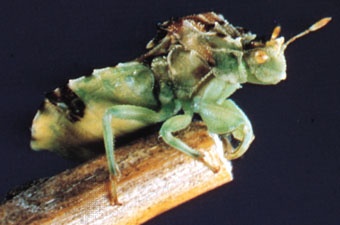ambush bug
insect
 any of about 200 species of bugs (order Heteroptera) that are most abundant in the tropical Americas and Asia and that hide on flowers or plants from which they ambush their prey. When prey approaches closely enough, the ambush bug grasps it with its front legs. The upper section (tibia) of each foreleg has teethlike structures that mesh into similar structures on the lower, greatly thickened leg section (femur). Holding its victim in these pincers, the ambush bug inserts its short beak and sucks out the body fluids. Even though the ambush bug is small (usually less than 12 millimetres, or 0.5 inch), its prey may be as large as a bumblebee, wasp, or butterfly.
any of about 200 species of bugs (order Heteroptera) that are most abundant in the tropical Americas and Asia and that hide on flowers or plants from which they ambush their prey. When prey approaches closely enough, the ambush bug grasps it with its front legs. The upper section (tibia) of each foreleg has teethlike structures that mesh into similar structures on the lower, greatly thickened leg section (femur). Holding its victim in these pincers, the ambush bug inserts its short beak and sucks out the body fluids. Even though the ambush bug is small (usually less than 12 millimetres, or 0.5 inch), its prey may be as large as a bumblebee, wasp, or butterfly.Ambush bugs have an odd shape, with lateral extensions and rounded projections. The Asian genus Carcinocoris is covered with spines. Phymata erosa, one of the most common North American representatives, is yellowish green and is usually found on goldenrod plants.
Some authorities place ambush bugs in the assassin bug family, Reduviidae, because they are predatory and have three-segmented beaks.
- Pashtun
- Pashupata
- Pashupati
- Pasig River
- Pasinetti, Francesco
- Pasiteles
- Paskevich, Ivan Fyodorovich, Graf Yerevansky, Knyaz Varshchavsky
- Paso, Fernando del
- Pasolini, Pier Paolo
- Paspalum
- Pasquale Fiore
- Pasquale Paoli
- Pasquale Stanislao Mancini
- Pasquier Quesnel
- Pasquier, Étienne
- Pasquier, Étienne, duc de
- pasquinade
- passacaglia
- Passaic
- Passaic River
- Passamaquoddy
- Passamaquoddy Bay
- Passarge, Siegfried
- Passarowitz, Treaty of
- Passau